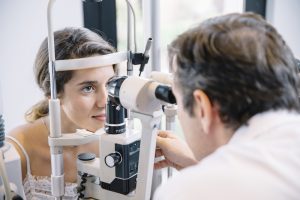Hormones necessary to help women maintain fertility levels might have a negative effect on their vision. However, there are appropriate therapeutic measures for afflicted women.
Female Reproductive Hormones
Chemicals, known as hormones, play a vital role in helping a woman’s body develop, particularly the reproductive system. Substances like estrogen and progesterone are key in the growth and function of the sexual and reproductive organs. These systemic components are paramount to a woman’s ability to conceive, become pregnant and ultimately give birth.
Should a woman’s body lack any of these critical hormones, numerous untoward physical manifestations may occur. Additionally, impacted individuals might experience significant difficulty becoming pregnant. That said, when systemic concentrations of estrogen are exceedingly high, unpleasant symptoms can also result.
The Connection Between Fertility Hormones and Vision Issues
When a woman experiences high bodily levels of reproductive hormones, eye and vision problems may occur. Women of childbearing age or those undergoing hormonal treatments for infertility may be especially susceptible because their systems often contain elevated concentrations of these substances.
Specific Vision Issues
Some of the vision issues that may arise due to these hormones are:

- Dry Eyes – Typically, this ailment occurs because the tear ducts become dry. Dry tear ducts do not produce enough water to maintain optimal moisture within the eyes. Afflicted individuals might experience manifestations like redness in and around the eyes, a stinging or burning sensation, itching and minor vision disturbances.
- Diminished Oil Production – Hormonal fluctuations can result in diminished oil production in the eyes and surrounding tissues. Eye oils help keep the organs lubricated and moist. Those lacking these substances may experience dry eye symptoms.
- Corneal Problems – Situated in front of the iris and pupil, the cornea plays an integral role in enabling light to enter the eye. Women afflicted with hormonal imbalances might experience greater elasticity within these ocular structures. Should this situation occur, the eye might alter the light refraction process, which can precipitate maladies such as blurred vision.
- Difficulty Wearing Contact Lenses – Any of the preceding issues could render wearing contact lenses more challenging or even painful.
Potential Corrective Measures
In many instances, the eye or vision issues associated with hormonal fluctuations are not permanent or serious and can be corrected by applying one or a combination of therapeutic protocols:
- Monitoring Eye Health – Healthcare professionals recommend that women of any age carefully monitor their eye health as part of their routine physical examinations or on separate occasions. General practitioners will usually examine a patient’s eyes and perform basic vision tests. That said, should any untoward occurrence be suspected, your doctor might recommend that you see an ophthalmologist, a specialist in eye issues.
- Maintaining a Healthy Diet – Certain foods contain nutrients that promote eye health. Such items include produce, fish, and grain products.
- Augmenting Diet With Nutritional Supplements – In certain instances, one’s diet might not be enough to ensure the body is receiving enough eye-protecting nutrients. Augmenting one’s diet through dietary supplementation can ensure the prevention of nutritional deficiencies.
- Protecting Eyes When Necessary – Individuals who spend significant durations outdoors or in potentially adverse conditions are strongly advised to wear protective gear like sunglasses or goggles.
- Obtaining Adequate Rest – Naturally, obtaining proper amounts of sleep enables the eyes to rest and regenerate. However, the eyes should be rested as often as possible. This is particularly true for individuals who spend extended periods working on computers or reading.





